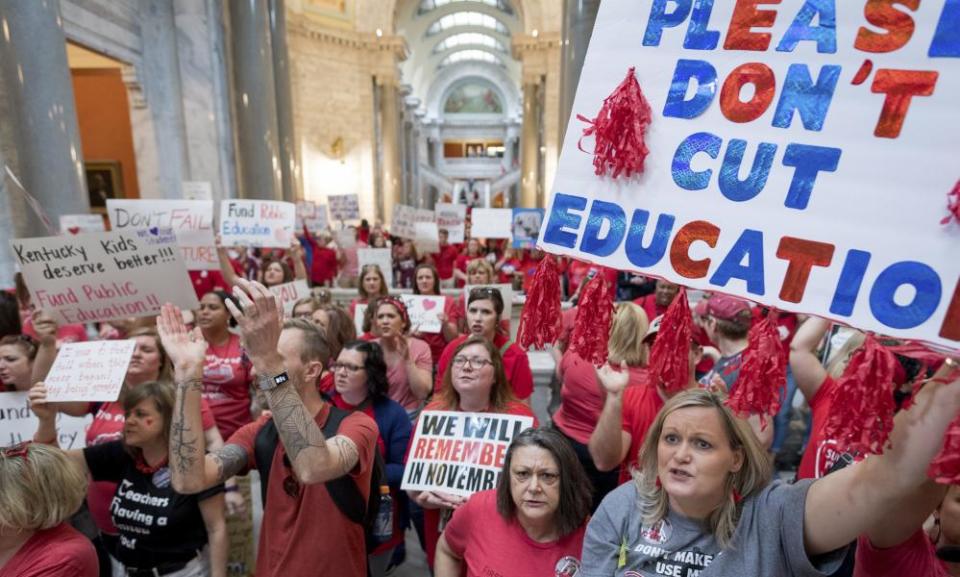North Carolina teachers join wave of strikes with one-day walkout
Thousands of teachers and supporters will rally at the state capitol to highlight low wages and poorly funded local schools

Teachers in North Carolina are launching a one-day walkout in the latest in a wave of strikes that have won significant victories across the US – and provided a jolt in the arm of the labor movement.
Thousands of teachers and their supporters are set to rally at the state capitol on what will also be the first day of the session for the North Carolina general assembly. The walkout aims to highlight low wages and poorly funded public schools.
Since 2009, real wages for teachers have fallen by 9.4% in North Carolina. Following a successful teachers’ strike in West Virginia in March, union organisers in North Carolina began discussing what they could do. Then they watched teachers in several other states go on strike too.
“We saw Kentucky, Oklahoma and Arizona, of course, and that momentum that has been building in these ‘right-to-work states’ is inspiring,” said Kristin Beller, a teachers’ union leader in Wake County, North Carolina.
It’s a bold move for North Carolina as teachers in in the state lack collective bargaining rights – something they hope helps launch a political movement. The strikes have worked in other states, In Oklahoma, teachers won an average $6,000-dollar raise. In West Virginia, the teachers’ strike won a 5% raise for all state workers.
But the North Carolina one-day walkout is likely the final major strike of this school year, as teachers and students prepare to break for summer recess. Union leaders hope that a display of power in North Carolina could help keep momentum as teachers organize throughout the summer. Their successes so far have won plaudits for teachers across America’s labor movement and beyond.
“These human shields, as I call them, have been incredibly important because they have changed the subject in a way that we have not been able to do since the recession about the importance of investment in public schools,” said Randi Weingarten, president of the 1.9 million-member American Federation of Teachers.
“What has happened is that [the media] has had to report the individual stories of some of the thousands of people that have been in these capitals, and that’s why I call them human shields, because they have been a shield for kids,” said Weingarten.
Indeed, teachers have won popular support for their cause, as polls in states where teachers have gone on strike have shown the public is solidly behind them.
“These legislators are shaking in their shoes. They know that they are going to be held accountable for what they have given those students,” said Lily Eskelsen García, president of the 3 million-member National Education Association. “We are going to see something big, because everybody is talking about public schools and how that can’t be continued.”
But challenges now loom for labor leaders hoping to keep their struggle in the public eye and keep their members organized over the summer.
Already, as media attention from the initial strikes fades away, some GOP state legislators are moving back to roll back wages. State legislators in Oklahoma have already repealed taxes on hotel and motels that were passed to pay for teachers’ raises. In Tucson, Arizona, teachers are finding out that due to state funding formulas that they won’t be received the 9% raise that they were promised when they ended their strike.
Teachers say that they intend to mobilize and keep a focus on legislators now backtracking on their promises.
“We won’t be fooled,” said Garcia.
In a potentially powerful show of political force, the two teachers’ unions have recruited a combined 400 teachers to run for office at the state level.
The American Federation of Teachers plans to hold a massive convention with over 3,000 teachers starting on 13 July. The focus will be on training members to run for office and rebuilding union structure that has been dilapidated in so many states.
Weingarten said she had never been so excited in her entire lifetime in the labor movement as she is now.
“I come from New York, and I’ve watched us in New York keep the density [of union members], so I’ve been excited my whole life about the potential of the labor movement,” Weingarten said. “What is exciting is that in places where despair was a strategy, that seems to be pierced and that is huge.”
Weingarten said it is now up to the labor movement to build an electoral infrastructure over the summer necessary to create lasting change in the fall.
“I think a lot about the Arab spring and I think a lot about Occupy and how you move from this inspiring moment to enduring change,” she said. “And you have to take the next step of electing people who believe in these values.”

